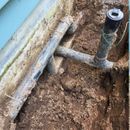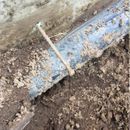Foundation waterproofing retrofit
Howdy. I know questions come up like this all the time but I’ve been reading a thousand pages on the subject and would appreciate some sanity-checking on my plan.
We bought a house last year that’s roughly two years old. I’m no expert, but I think it would be considered a mid-level build; it certainly isn’t a green/leed-level design.
We have a poured concrete foundation with a crawlspace. Heavy clay backfill. I’ve noticed some water intrusion into the crawlspace around some of the pipe penetrations; not a ton of water, but some.
I’ve excavated that area of the foundation (see photos). The pipes have some sort of sealant applied around them although it looks like it may be partially peeling off.
Some sections of the foundation had a tar emulsion applied to it (which I understand is considered “damp-proofing” not “water-proofing”).
So, since I’m going through the pain of excavating the area, I’d really like to do the job as right as possible, without breaking the bank.
From my readings, here’s what I’m planning:
- Excavate to footing and clean off all existing material
- Seal pipe penetrations, both side and out, with Masterseal NP1
- Apply a waterproof membrane coating. Looking at Masterseal HLM 5000
My questions:
- What do you think of those products? I’m hoping I can find places to purchase them as a DIYer
- I’ve read about protecting the waterproof membrane from backfill. What is a good DIYer product for that? I’ve read about polyethylene dimpled drainage mats, but I’m not sure if that’s overkill and/or what or where to purchase them. Some people suggest just using pond liner? I should just cut the pieces to fit around the pipes, I assume? And how best to adhere it?
- Many people suggest a perforated pipe / french drain / drain tiles, deeper than the footing. Do we think that’s necessary? I hesitate to have the additional cost and yet another system that can fail (clog) when there really isn’t that much water gaining access (currently).
- What are those metal bars extending from the foundation? Are those the form snap ties? Should they be removed and patched with hydraulic cement first? One person indicated they will rust but it’s not a worry since they should still stay water tight.
- Any other improvements I should consider making now, while it’s still open?
Thank you!
GBA Detail Library
A collection of one thousand construction details organized by climate and house part











Replies
Maurice,
It would be helpful to know your location or climate zone. Also, do you have gutters that redirect water away from the foundation? Is the ground around the house excavated so it slopes away from the foundation on all sides?
That the wall ties are still there is an indication of a quick, cheap job. As is the peeling dampproofng. If you have the slope of land to drain to daylight, and the time, I'd suggest excavating down to the footings and backfill correctly. Break off the ties, all the holes with hydraulic cement; let the concrete dry & coat with a good concrete sealer, or have someone spray it on; add washed stone and PVC drains (not the black slinky stuff), cover with landscape fabric and backfill with clean sand or gravel that will let water drain down to the pipes. (which need to be below the floor). This is the way it should have been done.
Combined, Steve and Bob's answers hit all the key points I can think of. I'll add just that rigid, smooth, white "triple wall" HDPE drainage pipe is another good option.
> It would be helpful to know your location or climate zone.
Sorry, yes.
We're in Portland, OR. IECC zone 4C. We're in the country, on 5 acres with a nearby creek.
> Also, do you have gutters that redirect water away from the foundation?
Yes, I think we're in good shape there. All of the gutters connect to an underground pipe that exits down the hill a ways away.
You can see it in that first photo, actually. The pipe that's running alongside the house is the gutter drainage pipe, I believe. The other pipe that's perpendicular to the foundation is the septic and it actually penetrates the foundation itself (and is where the small leak is).
> Is the ground around the house excavated so it slopes away from the foundation on all sides?
Not the best and I intend to improve that. It's good in some areas but marginal elsewhere.
Thank you!
> If you have the slope of land to drain to daylight, and the time, I'd suggest excavating down to the footings and backfill correctly. Break off the ties, all the holes with hydraulic cement; let the concrete dry & coat with a good concrete sealer, or have someone spray it on;
And a concrete sealer is different than a waterproof coating? Are there products you can recommend? There's so many product choices but a lot of them seem difficult to obtain by individual homeowners.
Would the Masterseal HLM 5000 serve this purpose, or no?
In terms of the concrete prep, what do you suggest? I was intending to pressure spray it off and then maybe use a stiff brush on it? How clean does it need to get before sealing?
> add washed stone and PVC drains (not the black slinky stuff), cover with landscape fabric and backfill with clean sand or gravel that will let water drain down to the pipes. (which need to be below the floor).
So essentially a french drain around the entire perimeter of the house, then? And those need to be tied together and exit somewhere too, right? Maybe it can tie into the gutter drainage pipe somewhere?
I've read that having the sand/gravel backfill without the PVC drains could actually make things worse, yes (if it's surrounded by clay soil, the gravel can act like a bowl where the water accumulates)?
Thanks for the suggestions. Sounds like this is becoming a bigger project. I'll look into the HDPE pipe too, Charlie, thanks.
Follow-up: what about applying the HLM 5000 waterproofing followed by EPS insulation? The insulation would protect the waterproof membrane and enhance energy efficiency a bit?
We have a concrete driveway and two concrete porches in back, so I'm not sure what we do with those? It's basically impossible to access the foundation in those areas without either re-doing the concrete pads or tunneling beneath them (which doesn't sound like a good plan)?
Maurice,
One way of looking at it is that you have only had small water intrusions where the services enter, and no other signs that there is a problem. It is also crawlspace, not a basement or finished room, so the consequences of any water making it's way in are in comparison quite minor.
Against that is the absence of what both good practice and most building codes require: damp-proofing and perimeter drains.
Are there any consequences to waiting to see if a problem develops, beyond the lingering uncertainty of knowing whether you might have to act in the future?
> Are there any consequences to waiting to see if a problem develops, beyond the lingering uncertainty of knowing whether you might have to act in the future?
Not really. Except not knowing how big the future bill might be if I fail to act now.
I've already excavated the area around the pipe penetrations, so I was just thinking I should do as much as possible as long as it's open. The back of the house is on a hill, so it's not a big deal to get drainage tile to sunlight.
But yes, I really don't know how paranoid I should be and where the sweet spot is in terms of rework. I don't want to throw money away. But I'd also rather not excavate this side of the house again ;)
I used [url=https://liquidrubberusa.com/products/foundation-sealant?utm_source=frm]Foundation Sealant[/url] to protect my foundation and exterior basement wall from water. After how one pipe near my house stater leaking and I found my stuff swimming in my basement I decided to make something it won't happen again.
Maurice,
I can't provide you with advice on which products to apply. To me, the physical details -- perforated pipe, crushed stone, landscape fabric, backfill -- matter more than the chemistry of the coatings. (Coatings won't keep water out of your basement, but the physical details described here will.)
Ignore the areas where access is blocked by your driveway and porches. Address the areas where access is easier and where you've noticed water entry problems. Do a good job with the footing drain, and extend the footing drain to daylight.
Exterior insulation is a good idea, although you will need to come up with a plan to protect the above-grade portion of the insulation, and you'll need to install Z-flashing between the top of the foundation insulation and the lowest course of siding.
You wrote, "I've read that having the sand/gravel backfill without the PVC drains could actually make things worse." That's not true -- as long as you have a functioning footing drain.
It won't hurt to install some tees and risers in your footing drain, as clean-outs.
Don't connect the drain pipes for your roof gutters with your footing drain system. Keep these systems separate, or else you might be injecting roof water into the soil near your foundation.
For more information, see this article: Fixing a Wet Basement.